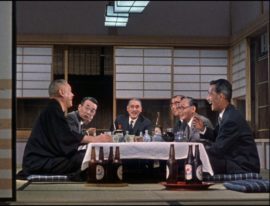A chair is still a chair
Even when there’s no one sitting there
But a chair is not a house
And a house is not a home
When there’s no one there to hold you tight
And no one there you can kiss goodnight
(A House Is Not a Home, Burt Bacharach and Hal David, 1964)
The first day of Il Cinema Ritrovato has certainly lived up to the festival’s name, at least for me, since both films I have seen have been discoveries in their own way.

I already knew An Autumn Afternoon (Sanma no aji, 1962) was a masterpiece in every conceivable way, but I had never seen the digital restoration that was screened at the Cinema Arlecchino in a pristine 35mm print. Having read David Bordwell on Ozu’s use of props in creating the distinctive graphic beauty his films possess, I couldn’t keep my eyes off the out of focus jars of sake and bottles of beer that make up the foreground of the recurrent planimetric ‘portraits’ Ozu ‘paints’ of his characters. (David will be lecturing on Ozu for a whole week, during the biennial Zomerfilmcollege in Antwerp. See his report of earlier editions of this Summer School here, here and here.)
Ozu’s use of colour, depth of focus and lighting creates a sense of space that is uniquely his own – experienced here in ideal circumstances – and which is inseparably connected to the tone and theme of his final film. The peculiar sort of nostalgia that flows from the sense of time passing is very acute in An Autumn Afternoon, a portrait of a widowed father and his only daughter. Ozu’s remarkable eye for space, both formally and thematically, reaches a highpoint in this truly beautiful film.
My rediscovery of Ozu’s timeless classic, was followed by the discovery of a lesser known film by another master: Max Ophüls’s Sans Lendemain (1940). Like Ozu, Ophüls is a master of the construction of cinematic space. Instead of Ozu’s geometric compositions and frames within frames, Ophüls uses sweeping tracking shots to guide us through Paris and it’s nightclubs, dimly lit streets, and apartments, but in the end evokes a similar sense of displacement. To Ophüls’s heroin Evelyn (an enchanting Edwige Feullière), her surroundings are a stage, whether it’s the nightclub where she performs as a burlesque dancer, or the apartment she rents to beguile her one time lover Charles. Like Ozu’s characters, she is faced with the fact that a house is not necessarily a home.
The entire Photogénie delegation at Il Cinema Ritrovato was enthralled by Ophüls’s poetic melodrama – inevitably, comparisons were drawn with last year’s champion, Jean Grémillon. An auspicious start to what will no doubt become yet another memorable week in Bologna.